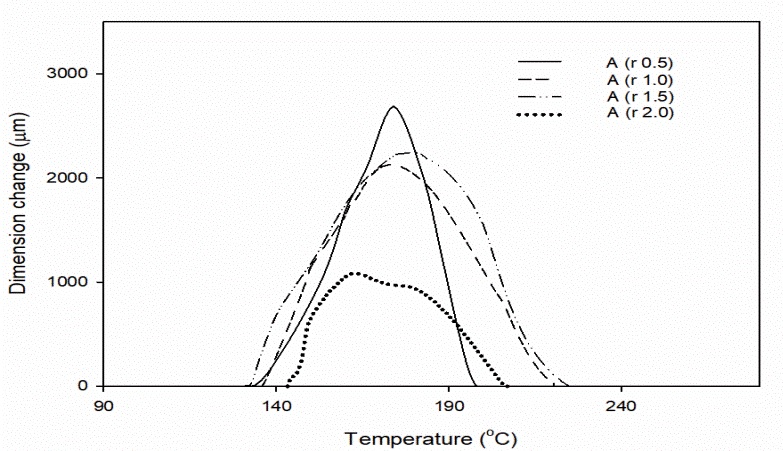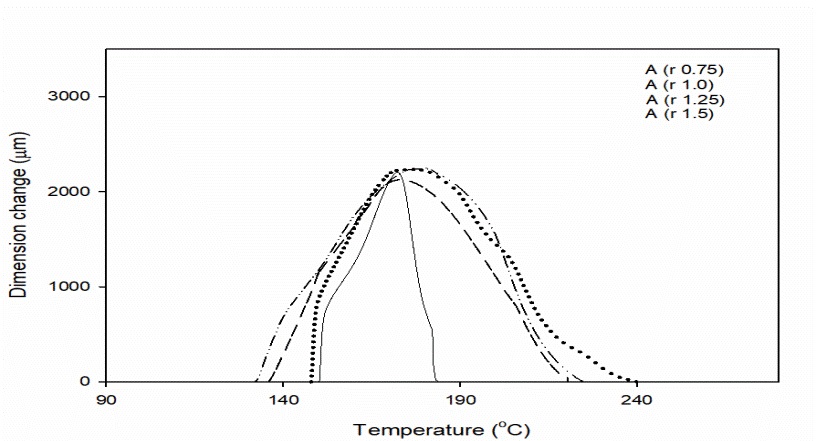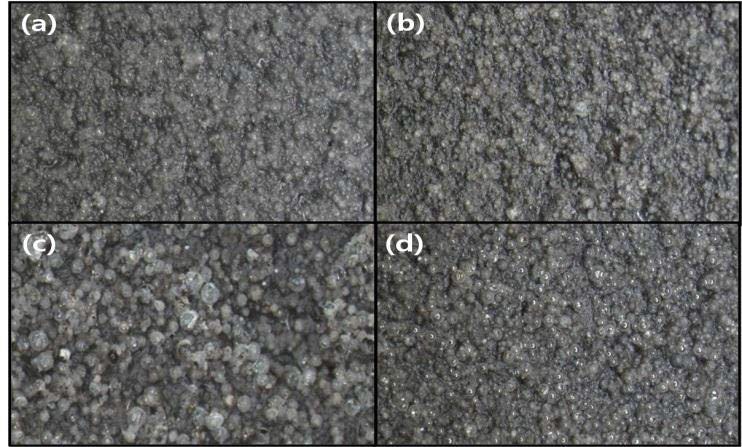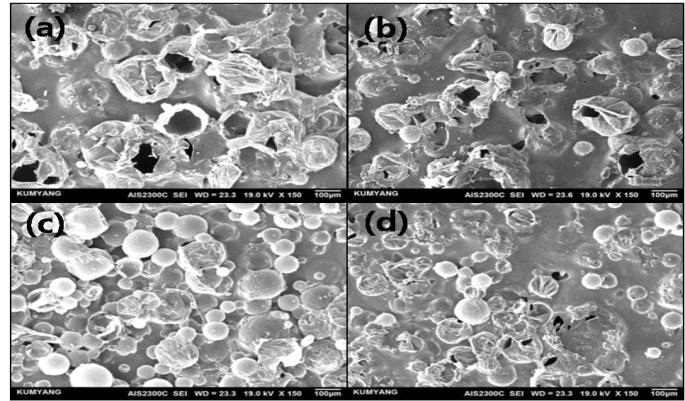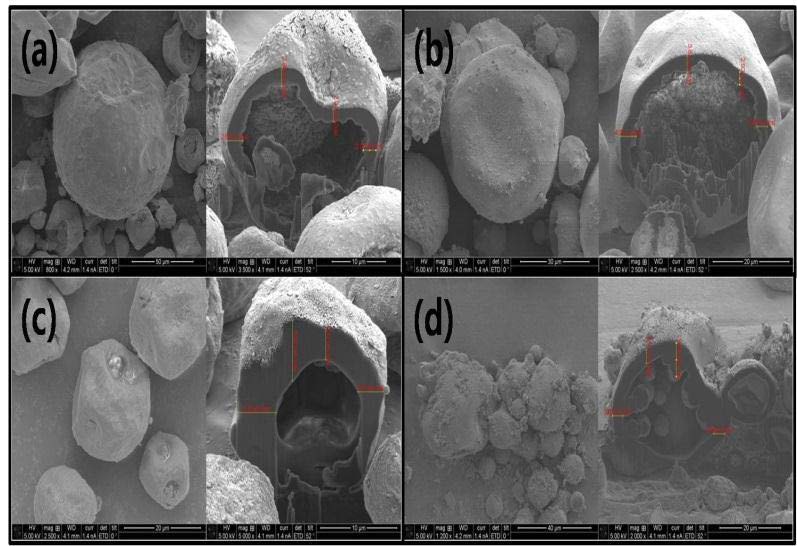Journal Name: Journal of Multidisciplinary Research and Reviews
Article Type: Research
Received date: 29 August, 2019
Accepted date: 03 September, 2019
Published date: 10 September, 2019
Citation: Ji-Hoo K, Jin-Wook P, Sang-Jin L, Sang-Hoon J, Hae-Na Y, et al. (2019) The Impacts of Shell Thickness of Thermally Expandable Microspheres on the Application of Vehicle Underbody Coating. J Multidis Res Rev Vol: 1, Issu: 2 (13-17).
Copyright: © 2019 Ji-Hoo K, et al. This is an open-access article distributed under the terms of the Creative Commons Attribution License, which permits unrestricted use, distribution, and reproduction in any medium, provided the original author and source are credited.
Introduction
This research was conducted to manufacture thermally expandable microspheres (TEMs) for vehicles’ underbody coating and to apply them on an industrial scale. TEMs heat resistance was studied depending on the ratios of a cross-linking agent and an initiator. This research focused on the content of a cross-linking agent and how it affected the results. The TEMs’ outer shell was thickened to solve the problem of the foam expansion ratio’s reduction that occurred due to the shrinkage after the maximum expansion (Tmax) was reached. After foaming, the crosssectional thickness and surface of the sample with thickened outer shell were observed. The TEMs with the thickened shell showed the least shrinkage, which indicated excellent shrinkage stability, even after prolonged exposure to heat.
Keywords
Thermally Expandable Microspheres, Cross-linking agent, Underbody coating.
Introduction
This research was conducted to manufacture thermally expandable microspheres (TEMs) for vehicles’ underbody coating and to apply them on an industrial scale. TEMs heat resistance was studied depending on the ratios of a cross-linking agent and an initiator. This research focused on the content of a cross-linking agent and how it affected the results. The TEMs’ outer shell was thickened to solve the problem of the foam expansion ratio’s reduction that occurred due to the shrinkage after the maximum expansion (Tmax) was reached. After foaming, the crosssectional thickness and surface of the sample with thickened outer shell were observed. The TEMs with the thickened shell showed the least shrinkage, which indicated excellent shrinkage stability, even after prolonged exposure to heat.
Keywords
Thermally Expandable Microspheres, Cross-linking agent, Underbody coating.
Introduction
In the course of global industrialization, the demand for vehicles reliant on fossil fuels grew. Fossil fuels and CO2 increased environmental pollution and led to the rise in global warming potential (GWP) [1]. Therefore, developing and advanced economies continuously invest in research on improving fuel efficiency through the design of light weight vehicles. One of the ways to reduce the weight of a vehicle is by applying foaming materials to the inside of the vehicle. Also, some studies focused on mitigating noise from the outside of the vehicle and reducing vibration of the vehicle floor by using foaming materials. In particular, during the underbody coating (UBC) procedure, foam is applied to the lower part of the vehicle to address the problem of noise and to prevent corrosion [2]. Although various materials are utilized for these purposes, polymeric microcapsules are used as fillers for their light weight [3]. Thermally expandable microspheres (TEMs) are polymers with an average particle size of 10-50 μm. They are composed of a polymer shell on the outer periphery and liquid hydrocarbons inside [4,5]. Foam is formed in the UBC process when the bottom of the vehicle is sprayed with PVC sol using a thermally expandable polymer under atmospheric pressure and, then, is fired by undergoing a heating process. Typically, airless coating is carried out after electrode position coating. The foaming process is completed in 3 steps: first baking, second baking, and third baking for coating and adhesion. In this process, the PVC sol adhered to the bottom of the vehicle expands due to TEMs. This expansion keeps the environment protected from vibrations and noise transmitted from the vehicle and outside [6-10]. However, in this process, adhesion and foaming processes are completed through heating in the primary, secondary, and tertiary bakings. Unlike the TEMs applied in other industries, such heating process requires heat resistance due to the process being performed for a long period of time.
In this study, the improvement in heat resistance, required for TEMs used for underbody coating in vehicles, aims to prevent the decrease in foam expansion ratio caused by the exposure to high temperatures for a long time. The test of the improvement in heat resistance was conducted after the PVC sol, blended with TEMs, was attached on a steel plate. The issue of improving resistance to discoloration was excluded from this study, because it was researched previously [11]. Another reason is that discoloration is not important here, as the PVC sol is used in the underbody of the vehicle.
As shown in many studies, TEMs consist of thermoplastics on the exterior and hydrocarbons in the interior [4]. Similarly, this research is based on the assumption that the volume expands when a thermoplastic resin is softened due to an increase in internal pressure caused by the change in phase of a hydrocarbon [5,10]. In this study, TEMs were synthesized by monomers such as acrylonitrile (AN) and methacrylonitrile (MAN). The outer shell of microspheres was polymerized by an initiator. The inner hydrocarbon was enclosed by a cross-linking agent.
This paper focused on the experiment related to the thickness of the outer shell depending on the amount of initiator and cross-linking agent to enhance heat resistance. This suggests that if TEMs are continuously exposed to heat they would shrink due to polymer degradation caused by internal pressure and prolonged external heat. Thus, we attempted to thicken the TEMs’ shell based on the initiator and cross-linking agent’s ratio.
Materials and Methods
The water phase containing colloidal silica (CS) and the oil phase containing a monomer, hydrocarbon (isopentane), initiator (benzoyl peroxide) and cross-linking agent (BDDMA, 1,4-butanediol dimethacrylate) were mixed at 1,000 rpm for 10 min using a homogenizor. After the suspension was prepared by spinning at a high speed, it reacted in a synthesis reactor for 16 h. The suspension was washed and then dried to obtain a specimen. Synthesis was carried out at 62ºC and 400 rpm for 16 h, under the pressure of 2 kgf/cm2 with the application of nitrogen substitution for 3 min in a synthesis reactor. In this experiment, a specimen of thermally expandable microsphere (TEM) was synthesized by controlling the amount of cross-linking agent.
The TEM’s thermal expansion properties were measured using a thermal expansion analyzer (TMA Q400, TA Instruments, New Castle, DE, USA) at a rate of 10ºC/min from 50ºC to 250ºC. The measured properties were the temperature at which the expansion started (Tstart), the temperature at which the maximum expansion was reached (Tmax), and the level at which the maximum expansion was reached (Dmax). The surface of synthesized microspheres was photographed by using a scanning electron microscope (SEM AIS2300C, Seron Technologies Co., Uiwang, Korea) and an optical microscope (E200LED, Nikon Instruments Inc., Melville, NY, USA). The average particle size of the synthesized microspheres was measured by using a particle size analyzer (Mastersizer 2000S, Malvern Instruments Ltd., England). In order to confirm the TEMs’ shell thickness, an observation using a focused ion beam (FEI, Hellios Nanolab 600, FEI company, Hillsboro, USA) was attempted. For the foaming test of synthesized TEMs, PVC (polyvinyl chloride) sol was prepared as a medium by mixing PVC (100g, LP170, LG Chem., Seoul, Korea), dioctyl phthalate (30g, Sigma- Aldrich Co., St. Louis, MO, USA), heavy calcium carbonate (60 g, Sigma-Aldrich) and BZ810P-5 (1g, Songwon, Seoul, Korea). Dried TEMs (1g) were added into the resulting PVC sol. Then, the mixture was blended.
A cold rolled steel sheet (CRS, 152×76 mm, 0.8T) was coated with the resulting mixture at a thickness of 200 μm. After coating, the specimens were heated at 110ºC for 10 s and allowed to settle on the cold rolled steel sheet. After that, the foaming process was conducted three times at the baking conditions of 110ºC for 15s under atmospheric pressure. Then, the foam expansion ratio was calculated by dividing the thickness before and after expansion.
Results and Discussion
The amounts of hydrocarbon, initiator, cross-linking agent, colloidal silica (CS) and monomers such as AN and MAN are listed in table 1. The total amounts were metered in 60% of the test reactor volume. Bu et al. selected 1,4-butnaediol methacrylate (BDDMA) as the optimal crosslink agent through the research of various crosslink agents. The used amounts of the initiator, cross-linking agent, CS, and monomers such as AN and MAN were the same and reacted under the same production conditions. The experiments were conducted depending on the amount of the initiator that is shown in table 1.
Table 1: Formulation of Thermally Expandable Microspheres (phm).
| Materials | A (r 0.5) | A (r 1.0) | A (r 1.5) | A (r 2.0) |
|---|---|---|---|---|
| AN | 80 | 80 | 80 | 80 |
| MAN | 20 | 20 | 20 | 20 |
| Iso-pentane | 15 | 15 | 15 | 15 |
| Cross-linking agent | 0.5 | 1.0 | 1.5 | 2.0 |
| Initiator | 1.0 | 1.0 | 1.0 | 1.0 |
| Colloidal silica | 20 | 20 | 20 | 20 |
| Water | 300 | 300 | 300 | 300 |
As the results in figure 1 show, the sample’s Dmax with the smallest amount of the cross-linking agent was the highest, and A (r 2.0) had a three times lower value of the dimensional change than A (r 0.5). Bu et al. reported that the capsules synthesized by adding 0.05 mol% of BDDMA produced about twice as much liquid hydrocarbons as the capsules without the cross-linking agent. This suggests that the internal hydrocarbon did not function as a foaming agent. In the case of A (r 2.0), it is thought that the amount of the cross-linking agent was high because it was almost impossible to foam on the TMA curve. In the case of A (r 0.5), the Dmax value was high, but the curve’s shape was sharp. This shows that the shrinkage of the microspheres was large after Dmax, when the heat was continuously increased. Kawaguchi and Oishi reported that microspheres with broader expansion temperature range were required in the process of various applications with different amounts of the cross-linking agent.
Figure 1: Effects of the cross-liking agents’ ratio on the TMA curve of thermally expandable microspheres.
In table 2, the Tstart, Tmax, and Dmax of A (r 2.0), which contained the largest amount of the cross-linking agent, were relatively low. As the amount of the cross-linking agent increased, the particle size grew and the span value indicating uniformity of the particle size increased greatly. The thickness-to-radius ratio of particles can be attributed to the collection distance, which significantly influenced particle diameter, although a smaller particle diameter had a correspondingly smaller amount of polymer shell [12].
Table 2:
| Codes | A (r 0.5) | A (r 1.0) | A (r 1.5) | A (r 2.0) |
|---|---|---|---|---|
| Tstart (oC) | 132.8 | 135.7 | 134.1 | 143.2 |
| Tmax (oC) | 174.2 | 173.9 | 179.8 | 162.8 |
| Dmax (μm) | 2689 | 2122 | 2238 | 1082 |
| Particle size (μm) | 25.5 | 27.3 | 27.8 | 34.2 |
| Span | 1.7 | 1.7 | 1.7 | 2.1 |
As a result, Dmax of A (r 0.5) was high. However, it could be expected that heat resistance was weak. Because there was a problem in the foam expansion ratio of A (r 2.0), the amounts of the cross-linking agent in A (r 1.0) and A (r 1.5) were expected to be appropriate. Therefore, an additional experiment was conducted.
Test results show that the particle sizes of A (r 0.75), A (r 1.0), A (r 1.25) and A (r 1.5) were normal between 27 and 28 μm. Also, there was no significant difference in Dmax as shown in figure 2. It was confirmed that the A (r 0.75) specimen sharply contracted when the temperature increased, after the maximum expansion. In particular, A (r 1.25) showed the least shrinkage after Dmax. It is thought that the dimension change value gradually decreased after Tmax or Dmax. Excessive cross-linking restricted foam expansion, whereas insufficient cross-linking resulted in a microballoon collapse and rupture [5].In subsequent tests, 50g of PVC sol and 1g of thermally expandable microspheres (TEMs) were blended in order to obtain the same results in foaming within polymer. In order to fix the blended PVC sol to CRS, it was dried at 110ºC for 10s and fixed. Then, the foam expansion ratio was measured after the process at 150ºC for 15 min. The foam expansion ratio of the foamed product was measured after each foaming time points of next 15 min and final 15 min (Figure 3).
Figure 2: Effect of the cross-liking agent ratio on the TMA curve of thermally expandable microspheres.
Figure 3: Effect of the cross-linking agent on the foam expansion ratio of thermally expandable microspheres.
The foam expansion ratio was measured every 15 minutes. Initially, all the thermally expandable microspheres were foamed. Also, their foam expansion ratios increased to 150%. However, all foam expansion rations decreased after the 2nd and 3rd foaming processes. At the end of the baking cycle and, consequently, coming back to room temperature conditions, the expanded microspheres have to recover their own stability and show excellent resilient performance [13]. Similarly to TMA results, the shrinkage reduction occurred more rapidly in the case of A (r 0.75) than the initial expansion ratio. In the case of A (r 1.25), shrinkage hardly occurred, which is considered to be most suitable for weakening heat resistance due to shrinkage when the TEMs for UBC were applied. The surface of the test specimen was observed through a microscope. In Figure 4 (c), the surface cells of the A (r 1.25) specimen applied with 1.25 phm were the most prominent, and their sizes were 200-250 μm. Kawaguchi and Oishi concluded that it was necessary to optimize the composition of a shell polymer and particle size for obtaining a uniform microballoon with high heat resistance. The surface was observed using SEM in order to identify the specimens more specifically. Except (c) in Figure 5, bursting of cells due to swelling or shrinkage was observed [14].
Figure 4: Microscopic images of the surface of thermally expandable microspheres containing cross-linking agents: (a) 0.75 phm, (b) 1.0 phm, (c) 1.25 phm, and (d) 1.5 phm.
Figure 5: SEM images of the surface of thermally expandable microspheres containing cross-linking agents: (a) 0.75 phm, (b) 1.0 phm, (c) 1.25 phm, and (d) 1.5 phm.
The purpose of this study was to prevent the shrinkage at high temperature by increasing the content of a crosslinking agent. The thickness of the TEMs’ shell was measured because shrinkage was prevented at high temperatures by reinforcing microspheres’ heat resistance through the reinforcement of the TEMs’ outer shell. Figure 6 shows the results of the analysis using FIB. In the cases of (a) and (b), where the cross-linking agent 0.75 and 1.0 phm were applied, the shell was not uniform. In the case of (d), it can be confirmed that the difference between the thick part and the thin part was larger than that of the other samples. In the case of (c), which is the most ideal shape, the thickness of the shell was larger than that of the other samples, and the shape was uniform in each part. This suggests that the foam expansion ratio did not decrease although the microspheres were continuously exposed to high temperatures as compared with the initial foam expansion ratio.
Figure 6: FIB images of the thickness of thermally expandable microspheres containing cross-linking agents: (a) 0.75 phm, (b) 1.0 phm, (c) 1.25 phm, and (d) 1.5 phm.
Conclusion
This research was conducted to apply multipurpose thermo-expandable microspheres to the underbody coating of a vehicle. In particular, the research focused on the reduction of contraction when the microspheres were applied at high temperatures by improving their heat resistance depending on the content of a cross-linking agent in the synthesis of thermally expandable microspheres (TEMs). Especially, when the cross-linking agent 1.25 phm was applied, the TEMs’ outer shell showed the thickest and most stable shape. Even after the actual foaming, the microgrooves that occurred due to foaming were the smallest in SEM micrographs. Also, a uniform sphere of 200- 250 μm was formed as per our microscopic observation. It is considered that the TEMs with a more stable structure, due to the effect of cross-linking in the polymerization process due to the initiator, were more excellent in their heat resistance performance. This confirms the contents more clearly through cross-section confirmation using FIB. It is considered that it is easy to apply the TEMs requiring heat resistance.
Acknowledgement
This research was supported by the World Class 300 Project R&D Support Project (S2433278) of Korea Ministry of SMEs and Startups.
There are no references
